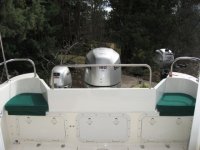Sea Skipper
Member
- Joined
- Jan 22, 2005
- Messages
- 52
- Reaction score
- 0
- C Dory Year
- 2005
- C Dory Model
- 25 Cruiser
- Hull Identification Number
- 25126
- Vessel Name
- Sea Skipper
Lately I find my self remembering some of the high wind against current short period steep waves I was in earlier this summer and thinking about methods to raise the splash well on my CD25 "Sea Skipper". Several owners have successfully done this on their CD22s, but it is not so easy a task on the 25 due to the transom seats. Before I get carried away with worry and perhaps design some useless addition which only gets in the way; I thought I should ask if any C-Dory owner has actually experienced a wave over the stern and lived to tell about it. A CD25 was lost in Cook Inlet, Alaska last year due to being effectively anchored stern to the waves (posts indicated that the rode fouled around outboard lower unit while weighing anchor). To my knowledge, I have never come close to being pooped, but I have only taken brief glances astern when it is that rough out. Thanks -

